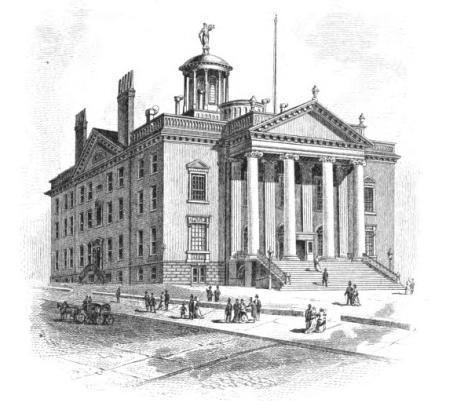Members 32 Members 126 | Party control Split (16-16) | |
 | ||
Term July 1, 1821 – December 31, 1822 President Lt. Gov. John Tayler (Clint.) | ||
The 45th New York State Legislature, consisting of the New York State Senate and the New York State Assembly, met from January 2 to April 17, 1822, during the fifth year of DeWitt Clinton's governorship, in Albany.
Contents
Background
Under the provisions of the New York Constitution of 1777, amended by the Constitutional Convention of 1801, 32 Senators were elected on general tickets in the four senatorial districts for four-year terms. They were divided into four classes, and every year eight Senate seats came up for election. Assemblymen were elected countywide on general tickets to a one-year term, the whole Assembly being renewed annually.
In 1797, Albany was declared the State capital, and all subsequent Legislatures have been meeting there ever since. In 1818, the Legislature enacted that future Legislatures meet on the first Tuesday of January of each year unless called earlier by the governor.
State Senator Gideon Granger resigned in 1821, leaving a vacancy in the Western District.
On March 13, 1821, the 44th New York State Legislature passed a bill to submit the question, whether a Constitutional Convention should be called, to the voters at the next State election in April 1821.
In 1821, Erie County was split from Niagara County, but remained with Cattaraugus, Chautauqua and Niagara in one Assembly district. Livingston and Monroe counties were formed from parts of Genesee and Ontario counties, and were apportioned one seat each in the Assembly, taken from Ontario.
At this time the politicians were divided into two opposing political parties: the Federalists and the Democratic-Republicans. The Democratic-Republican Party was split into two factions: the Clintonians (supporters of Gov. DeWitt Clinton) and the Bucktails (led by Martin Van Buren, and including the Tammany Hall organization in New York City). The Federalist Party was disbanding, the majority joined the Clintonians, a minority joined the Bucktails.
Elections
The State election was held from April 24 to 26, 1821. Abel Huntington (Southern D.), Abraham J. Hasbrouck (Middle D.), David C. Judson, Daniel Shipherd, John L. Viele (all three Eastern D.), Henry Seymour ( Western D.); and Assemblymen Abraham Gurnee (Southern D.), Archibald McIntyre (Middle D.) and Samuel M. Hopkins (Western D.) were also elected to the Senate. Huntington, Gurnee and Seymour were Bucktails, the other six Clintonians.
At the same time, the question whether a Convention to amend the New York Constitution should be called, was answered in the affirmative by the voters, and delegates to the Constitutional Convention of 1821 were elected in June.
Sessions
The Constitutional Convention met from August 28 to November 10, 1821, and the new Constitution was adopted by the voters in January 1822.
The Legislature met at the Old State Capitol in Albany on January 1, 1822, and adjourned on April 17.
Samuel B. Romaine (Buckt.) was elected Speaker with 74 votes against 44 for George Huntington (Clint.). Edward Livingston (Buckt.) was elected Clerk of the Assembly with the same vote against Sandford Cobb (Clint.).
On April 12, the Legislature re-apportioned the Assembly districts. All multiple-county districts (except Hamilton and Montgomery) were dismembered, and every county became a district. The total number of assemblymen was increased from 126 to 128.
On April 17, the Legislature enacted that future State elections be held on the first Monday in November and the two succeeding days.
Districts
Members
The asterisk (*) denotes members of the previous Legislature who continued in office as members of this Legislature. Abraham Gurnee, Archibald McIntyre and Samuel M. Hopkins changed from the Assembly to the Senate.
Under the provisions of the new Constitution, all senators were legislated out of office at the end of 1822. The whole Senate was renewed at the State election in November 1822, the term of the new senators beginning on January 1, 1823.
Employees
Assemblymen
The asterisk (*) denotes members of the previous Legislature who continued as members of this Legislature.
